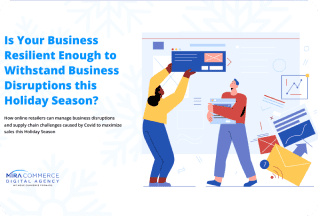It is quite apparent the COVID-19 pandemic is not just a short-term crisis and has majorly shifted consumer behavior. With online shopping far exceeding traditional sales, and millions of shoppers anxiously waiting for the biggest shopping day(s), it is every online retailer’s and marketer’s wish for that boost of holiday sales. Last year, U.S. e-commerce revenue set a record of $3.34 billion on Black Friday – a substantial 21.6% year-over-year growth rate. What does this mean for the e-commerce industry? Consumers are actively spending more time online to search holiday promotions. The overly competitive market during the holiday season makes it hard to stand out and reel your customers to shop your site, especially when you stand against the giant, Amazon, who can fill just about any category of consumer needs. We breakdown some of the most pressing issues online retailers face today and compiled some of the best tactics to accelerate your customer satisfaction to see a results-driven difference.
Challenge: Competing with Amazon
Best Practice Solutions: Make your holiday landing page available earlier – allow your customers to browse and select items prior to Black Friday and Cyber Monday deals. Since Amazon offers deals prior to Black Friday, offer your customers discounts earlier as well. In a report by Adwords, 61% of holiday shoppers begin searching online for their purchases prior to the weekend of Thanksgiving. Since Amazon is secretive with the numbers, Internetretailer.com took a dig and estimated that 40% of the total sales was accredited to Amazon from Thanksgiving to Cyber Monday. Set your business up to collect preorders, optimize mobile shopping experience, and always make sure your website is user-friendly.
Challenge: Supply-chain disruption, inventory shortages. COVID-19 has had a severe global disruption on supply chains, distribution, cross-border shipments, operations, and costs, causing a major lack of supply. A study shared by Accenture reports that 94% of Fortune 100 companies are seeing supply chain disruptions forcing them to reshape their supply chains to enable long-term resiliency.
Best Practice Solutions: Here are some key steps to build a resilient supply chain and rebound from economic retail challenges.
- Optimize your supplier network to manage inventory, supplier relationship, and risk more effectively: Supply chain design, planning and execution starts with the network design process and how product flows between facilities with strong objectives for demand forecasting, establishing supplies, and planning and scheduling manufacturing operations. Creating a strategic deployment plan, inventory planning and coordinating assets to optimize delivery of goods. Focus on executing applications and systems for inventory, warehousing, transportation, and global trade management.
- Forecast demand more accurately: leverage data to maximize visibility of demand, inventory, capacity, and supply to balance supply and demand. Getting insight on data could lack visibility because data is siloed. A supply chain optimized through connected technology is the best solution for informational silos.
- Mobilize & Configure: mobilize dedicated planning and execution teams for better visibility across the entire supply chain ecosystem.
- Digitize: implement real-time order monitoring, inventory visibility, and renew logistics operating models to increase operational efficiency.
Building agility now through automated catalog listings, order, and inventory management via a centralized platform will set your business up for the future to introduce new consumer experiences without high overhead costs. Making the best use of technology resources such as AI and IoT will improve efficiency and performance in a supply network. Optimizing technology is key to remaining competitive and gaining better visibility and better decision-making capabilities in real time.














